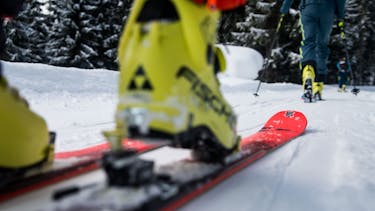
Art of Track Setting
You’re stuck inside. What better time to improve uphill travel techniques to use when next year’s snow starts to fly? First up: Rob Hess, IFMGA guide and co-owner of Jackson Hole Mountain guides, explains the art of setting a skin track. You’ll know when you’ve learned to set good skin tracks when you start admiring your up tracks, more than your down tracks.

Efficient Skin Track Setting
In this video, guides Matt Farmer and Mike Hattrup, set a typical US skin track—inefficient and too steep—then attempt to defend it with usual, but inaccurate justifications. Tune in to the discussion between those two, and Margaret Wheeler and Rob Hess, who put in an efficient track, so you understand why “straight up” should be reserved for cocktails.

Rounded Turns
Changing directions while skinning should be a no brainer. There’s a simple progression—rounded turn, A-V-A turn, and kick-turn—that will make your skin tracks efficient, easy to follow and even aesthetic. In this video, AMGA guide and Fischer US Product Manager, Mike Hattrup, discusses strategies to identify where and when to make a rounded turn, so that you can be proud of your skin tracks when venturing out next winter.

A-V-A turn
The A-V-A turn is perfect for that awkward incline that’s too steep for a rounded turn, but not steep enough to require a kick turn. If you have some spare time (and with “shelter in place”, we know you do), join AMGA guide and Fischer US Product Manager, Mike Hattrup as he explains how and when to use the kick-turn’s lesser known sibling, the A-V-A turn.

Kick Turn
It might not be the Mona Lisa or Starry Night, but a well-executed kick-turn is its own thing of beauty. Here IFMGA guide Margaret Wheeler shows you a few different kick turns to smooth out your change of tack, so that when next season rolls around, you look forward to doing kick-turns, instead of dreading them.

Skin Care
Knowing how to use your equipment properly is key to a safe, fun day out. This means making sure your skins are properly cared for and stored during the summer months, so you can log vert season after season.

Beacon Check
Instead of binge-watching Netflix, brush up on your beacon skills while you’re cooped up inside. IFMGA guide Margaret Wheeler demonstrates a proper beacon check along with tips for storing and caring for your beacon so that it’s in tip-top shape for winter 20/21. Last, make sure to remove the batteries over the summer so they don’t corrode and ruin your expensive beacon.

Beacon Range Check
IFMGA guide Margaret Wheeler shows how to check your beacon’s range. Now if we could just get everyone to wear one, we could use beacons to practice proper “social distancing”.

Emergency Shelter
Stuck at home? Join Rob Hess, IFMGA guide and co-owner of Jackson Hole Mountain Guides as he shows you how to dial in your emergency shelter building skills. They’re pretty fun to build, and the warmth and shelter they provide makes them surprisingly comfortable; this is a skill that could save your life someday. The side benefit is that you’ll quickly realize that “sheltering at home” is actually pretty cush.



